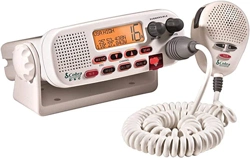Loading ...
Loading ...
Loading ...

Nothing Comes Close to a Cobra
®
Voice Calling
7
Limits On Calling
You must not call the same station for more than 30 seconds at a time.
If you do not get a reply, wait at least two minutes before calling again.
After three calling periods, wait at least 15 minutes before calling again.
Change Channels
After contacting another station on a calling channel, change immediately
to a channel which is available for the type of message you want to send.
StationIdentication
Identify, in English, your station by your FCC call sign, ship name, the state registration
number, or other ofcial number at both the beginning and end of each message.
Prohibited Communications
You MUST NOT transmit:
n
False distress or emergency messages.
n
Messages containing obscene, indecent, or profane words or meaning.
n
General calls, signals, or messages (messages not addressed to a particular station)
on Channel 16, except in an emergency or if you are testing your radio.
n
When you are on land.
Voice Calling
•
To Call Another Vessel Or A Shore Installation Such As A Lock Or Bridge Tender:
n
Make sure your radio is On.
n
Select Channel 16 and listen to make sure it is not being used.
NOTE
Channel 9 may be used by recreational vessels for general-purpose
calling. This frequency should be used whenever possible to relieve
congestion on Channel 16.
n
When the channel is quiet, press the Talk button and call the ship you wish to call.
(Hold the microphone a few inches from your face and speak directly into
it in a normal tone of voice — clearly and distinctly.) Say “[name of station
being called] THIS IS [your vessel’s name or call sign].”
n
Once contact is made on the calling channel, you must switch to a proper working
channel. See the channel listing on page 58 through 61.
VHF Marine Radio Protocols
6
English
VHF Marine Radio
Procedures
Canadian Ship Station License
You need a Radio Operator’s Certicate if your vessel is operated in Canadian waters. Radio
Operator training and certication is available from the Canadian Power Squadron. Visit their
website (http://www.cps-ecp.ca/english/newradiocard.html), contact the nearest eld ofce
or write: Industry of Canada, Radio Regulatory Branch, Attn: DOSP, 300 Slater Street, Ottawa,
Ontario, Canada K1A 0C8.
User Responsibility And Operating Locations
All users are responsible for observing domestic and foreign government regulations and are
subject to severe penalties for violations. The VHF frequencies on your radio are reserved for
marine use and require a special license to operate from land, including when your boat is on
its trailer.
NOTE This device complies with part 15 of the FCC Rules. Operation is subject to the
following two conditions: (1) This device may not cause harmful interference, and (2)
This device must accept any interference received, including interference that may
cause undesired operation.
FCC Warnings: Replacement or substitution of transistors, regular diodes,
or other parts of a unique nature, with parts other than those recommended
by Cobra may cause a violation of the technical regulations of part 80 of the
FCC Rules, or violation of type acceptance requirements of part 2 of the rules.
VHF Marine Radio Procedures
•
Maintain Your Watch
Whenever your boat is underway, the radio must be turned On and be tuned to Channel 16,
except when being used for messages.
Power
Try 1 watt rst if the station being called is within a few miles. Try a second call after waiting
two minutes. If there is no answer, switch to a higher power. This will conserve your battery and
minimize interference to other users by avoiding repeated calls.
Calling Coast Stations
Call a coast station on its assigned channel. You may use Channel 16 when you do not know
the assigned channel.
Calling Other Vessels
Call other vessels on Channel 16 or on Channel 9. (Channel 9 is preferred for recreational
vessel use.) You may also call on ship-to-ship channels when you know that the vessel is
listening on a ship-to-ship channel.
Initial Calling on Channel 16 or 9
The use of Channel 16 is permitted for making initial contact (hailing) with another vessel.
The limits on calling must be followed. Be reminded, Channel 16’s most important function is
for Emergency Messages. If, for some reason, Channel 16 is congested, the use of Channel
9, especially in U.S. waters, may be used as the initial contact (hailing) channel for non-
emergency communication.
VHF Marine Radio Protocols
Loading ...
Loading ...
Loading ...
